Pros
Cons
Introduction
Front
{{section_header}}{{section.name}}{{/section_header}}
No bells and whistles here—just a sheet of stainless steel with a straight handle. Looked at from the outside, the Nutid dishwasher just seems to say, “I’m a dishwasher. Don’t worry which kind.”
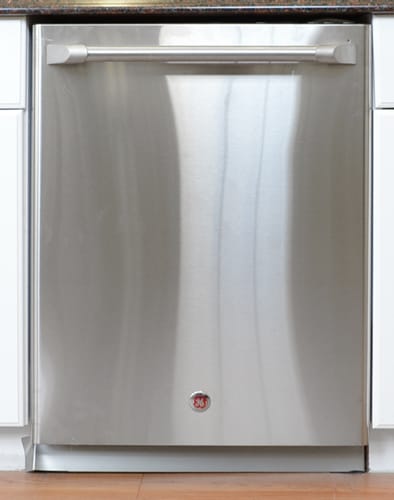
The front of the GE CDWT980VSS.
Finish
{{section_header}}{{section.name}}{{/section_header}}
The stainless steel finish is sturdy and somewhat dark. While it's sure to fit well in most kitchens, it’s not exactly impervious to fingerprints.

Controls
{{section_header}}{{section.name}}{{/section_header}}
The Nutid’s control panel is pretty nifty, but we’d expect more from Bruce Wayne. Cycle and wash options are indicated by a blue light, and a status display on the right side reveals each stage of the wash cycle. And that's cool, too.
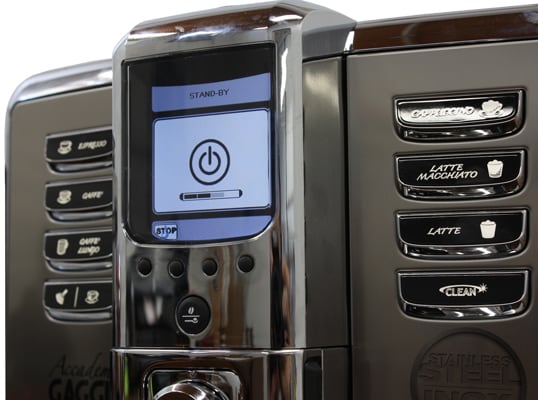
Interior
{{section_header}}{{section.name}}{{/section_header}}
The stainless steel interior serves more of a practical function than a design feature, as it helps expedite the drying process. But it certainly looks nice.
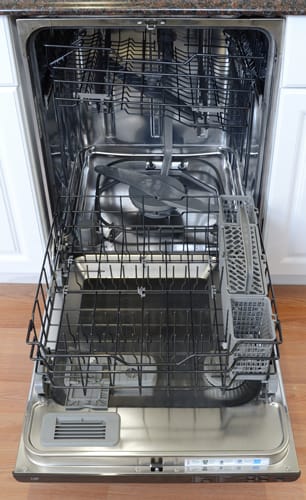
The CDWT980VSS with door open.
Top Rack
{{section_header}}{{section.name}}{{/section_header}}
The top rack is made of a sturdy plastic with a gray coating. There are four rows of tines, two of which are collapsible, plus four rows of angled spindles for fitting glasses, mugs, and other small dishware.
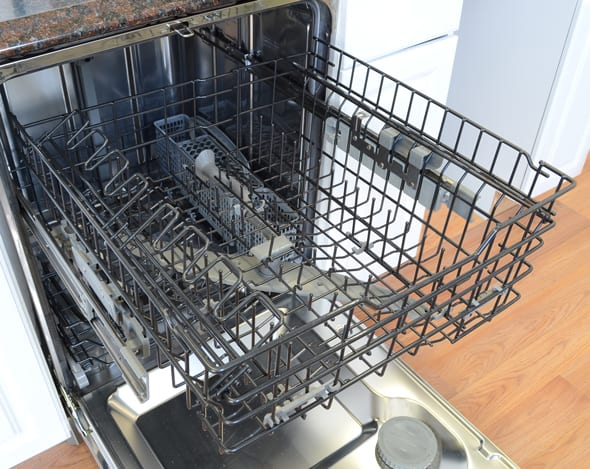
The top rack of the CDWT980VSS.
Bottom Rack
{{section_header}}{{section.name}}{{/section_header}}
The bottom rack includes seven rows of rigid, non-adjustable vertical tines, giving the overall appearance of a bed of nails.
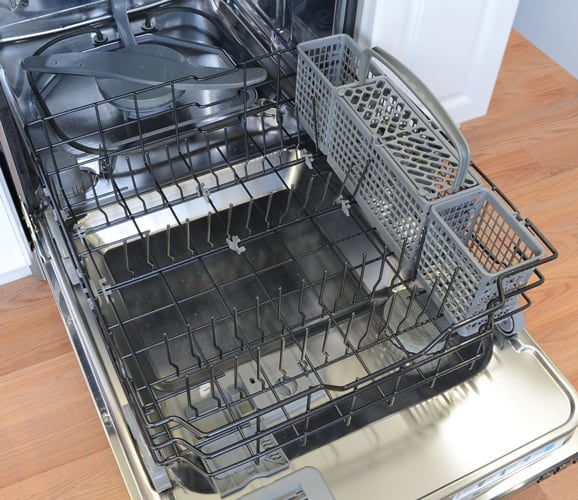
The bottom rack of the CDWT980VSS.
Cutlery Basket
{{section_header}}{{section.name}}{{/section_header}}
The cutlery basket looks like some sort of absurdist rabbit. Truly one of the oddest cutlery baskets we’ve come across, the thing has two disproportionately large handles that look like bunny ears, plus a number of variously shaped bays for, you know, fitting stuff. The lack of individual slots also makes it more difficult to fit large utensil loads.
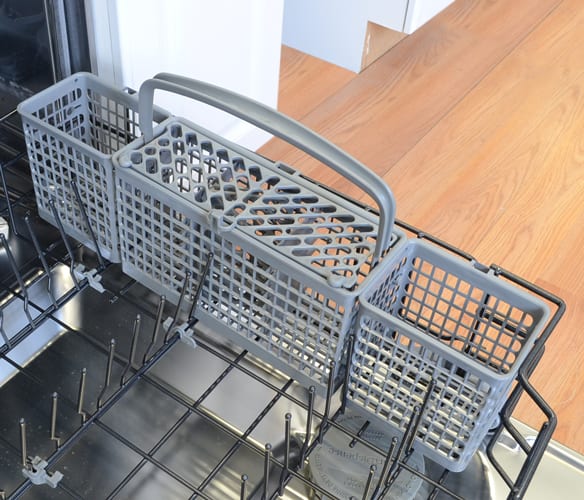
The CDWT980VSS cutlery basket.
Electricity Use
{{section_header}}{{section.name}}{{/section_header}}
Between the Light/China cycle and the Heavy wash, the Nutid uses 0.52 - 1.02 kWh per wash. Somewhat of an average figure, this makes for a cost of roughly 5 to 11 cents per wash—not bad, but certainly not ideal.

Water Use
{{section_header}}{{section.name}}{{/section_header}}
The Nutid dishwasher was less efficient in its water consumption, but once again, it wasn’t deplorable. The Light/China cycle soaked up 5.93 gallons of hot water, compared with 6.35 gallons in the Normal, and 8.03 in the Heavy, neither of which are very efficient numbers. This level of consumption will make for a water cost of 6 to 8 cents per wash.
Yearly Running Cost
{{section_header}}{{section.name}}{{/section_header}}
Each wash load will cost a total of 14 to 22 cents per wash (14 cents on the Light, 16 on the Normal, and 22 on the Heavy). Based on these above figures, and the assumption that the Normal cycle is used 50 percent of the time, the Ikea Nutid dishwasher can be expected to cost $34.67 per year. This is a slightly above average figure and certainly pales in comparison to Ikea’s Swedish compatriot Asko, which boasts one machine (the D5434XXLS) that costs an average $24.22 per year—with superior performance to boot.
Washing Speed
{{section_header}}{{section.name}}{{/section_header}}
No one will be impressed by the Nutid’s speed, but no one will be frustrated by it either. The Light/China wash was the quickest, but at 88 minutes it wasn’t quick enough to be considered a “quick” cycle. The Normal wash took a little under two hours to complete (119 minutes), and the Heavy cycle a little more (133 minutes).
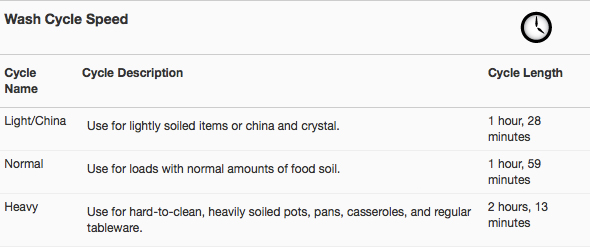
Washing Performance
{{section_header}}{{section.name}}{{/section_header}}
We were pleasantly surprised by the Nutid’s cleaning performance. It offered a robust clean on some of our most difficult tests. While it wasn’t perfect and received a lower score due to the lack of a quick cycle, it’s not difficult to recommend the Nutid dishwasher based on wash performance alone.
Quick Wash Cycle
{{section_header}}{{section.name}}{{/section_header}}
Our chief complaint about the Nutid: no quick cycle!
Normal Wash Cycle
{{section_header}}{{section.name}}{{/section_header}}
The Normal cycle was very impressive. While its peak temperature of 158.2 degrees was reached during the drying stage, it certainly got hot enough to melt proteins, meaning it did well on egg and meat tests. It also did well removing dried spinach and oatmeal, and whatever food stains remained were negligible. A very thorough clean.
Normal Cycle
Heavy/Pots & Pans Wash Cycle
{{section_header}}{{section.name}}{{/section_header}}
The Heavy cycle did well in each test category. What was really impressive was its perfection in our burnt cheese test—truly a rarity in the world of standardized dishwasher testing. While this was kind of amazing, it’s worth noting that it didn’t actually melt the cheese—it left it caked around the wash tub filter, making for a rather filthy cleaning process. But because the Normal and Heavy washes both offered strong performances, we would recommend choosing the Normal cycle far more often, as it’s more efficient.
Pots & Pans Cycle
Washing Cycles
{{section_header}}{{section.name}}{{/section_header}}
There are three cycles: Light/China, Normal, and Heavy, plus a Rinse Only option, which is typically used to soak dishes in preparation for washing at a later time.
Customization
{{section_header}}{{section.name}}{{/section_header}}
In this case, the wash options are essentially the same as the customization options, as they can all be added to individual cycles. They include: a Sanitize option, which heats the water to a bacteria-killing temperature (155 degrees); a High Temp wash, which is essentially the same thing; and a Heated Dry, which hopefully is self-evident in what it does. There’s also a 4 Hour Delay, allowing you to postpone the start of your wash cycle.
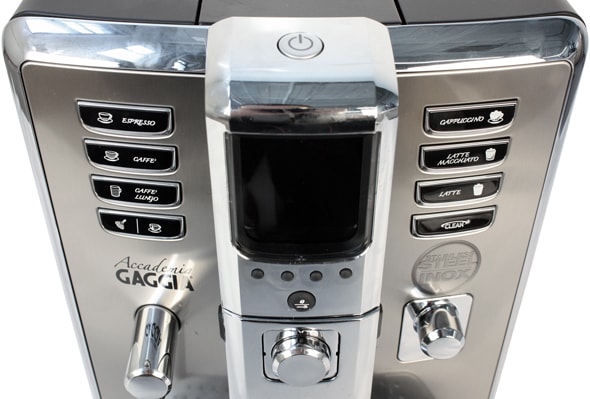
Additional Wash Options
{{section_header}}{{section.name}}{{/section_header}}
In addition to the above mentioned options, there’s a Rinse Only feature and an interface display that shows you the status of your wash: Washing, Drying, Clean, or Sanitized.

Capacity
{{section_header}}{{section.name}}{{/section_header}}
We were able to fit 10 place settings in the Nutid dishwasher, including a serving setting. This is a fairly standard score for a modern dishwasher. We don’t imagine you’ll have much trouble fitting your dishes, and the racks are designed well enough to allow for flexibility when loading.
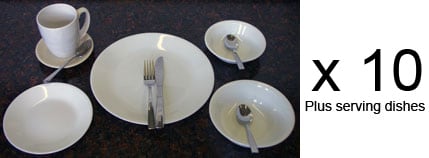
Top Rack
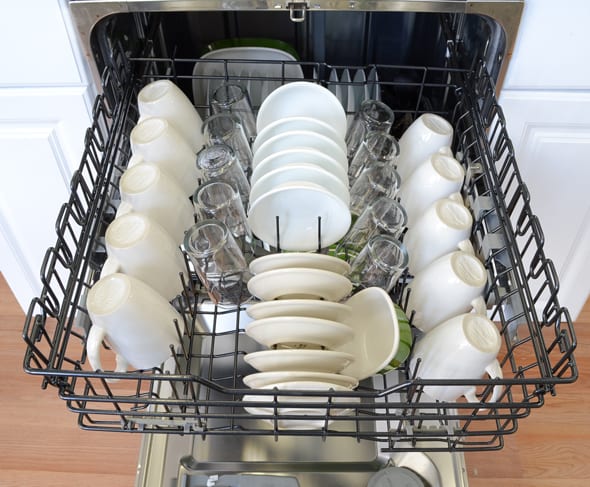
Bottom Rack
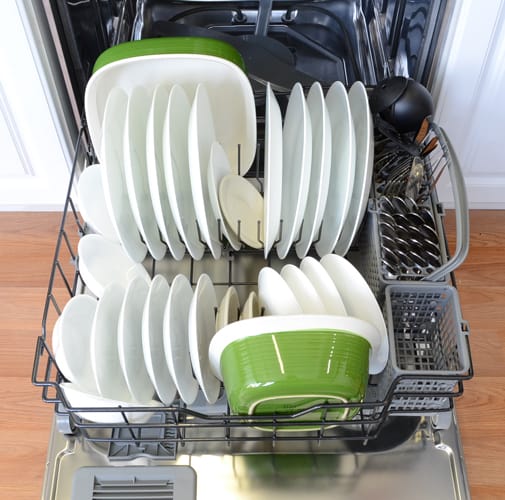
Wash Arms & Filters
{{section_header}}{{section.name}}{{/section_header}}
The lower wash arm is made of a sturdy metal, which surely aids in the force of the water pressure and helps explain the impressive wash performance. The upper wash arm is made of plastic but does its job.
The filter is an interesting design; it looks like a brake rotor and even seems to have a hub cap of some sort (it’s the Batmobile!). Unfortunately, it can’t be removed for manual cleaning, but we didn’t find this to be too much of a problem.
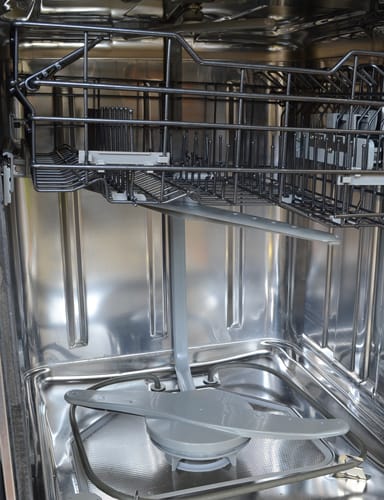
The CDWT980VSS wash arms.
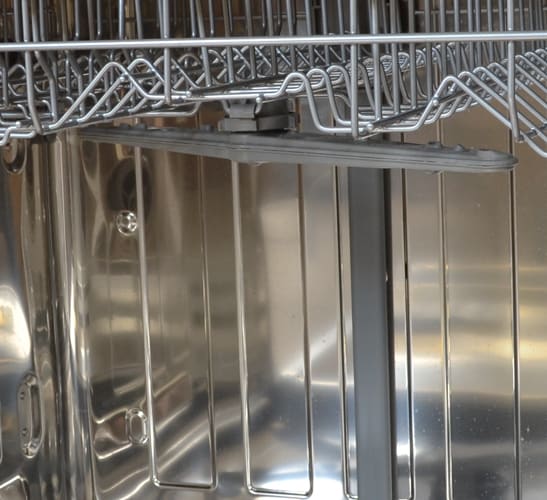
The DW 14140 upper wash arm
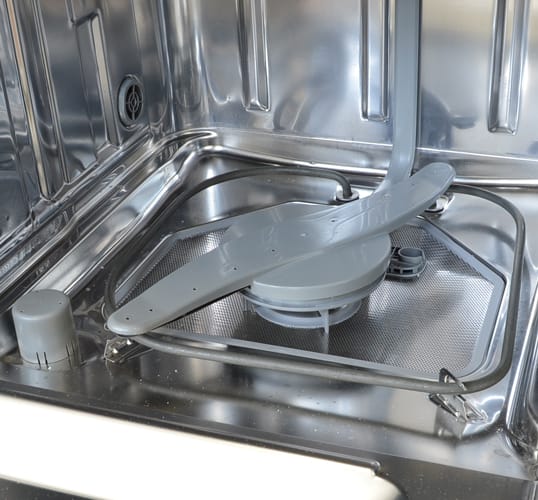
The CDWT980VSS filter.
Lower Dish Rack
{{section_header}}{{section.name}}{{/section_header}}
For a dish rack with vertical tines and a complete lack of adjustability, it's surprisingly flexible. Loading oddly shaped dishes didn’t require some act of God to fit, and there was still sufficient room.

The bottom rack of the CDWT980VSS.
Upper Dish Rack
{{section_header}}{{section.name}}{{/section_header}}
The layout includes a number of angled tines and spindles to allow for considerable loading capacity, but the rigidity of the lower rack lowered the machine’s overall capacity score.

The top rack of the CDWT980VSS.
Cutlery Holder
{{section_header}}{{section.name}}{{/section_header}}
Just when you think you’ve seen the full range of cutlery baskets, there comes something truly strange. Yes, the basket serves its basic function, but what crackpot designed this thing? It’s just strange-looking.
On a more practical note, the bays of the cutlery basket are pretty shallow, which made it difficult to load larger utensils such as ladles and spatulas. In the grand scheme of things the cutlery basket isn’t too important (and this is reflected in our score weightings), but it’s worth noting the silliness of this thing’s design.

The CDWT980VSS cutlery basket.
Detergent Dispenser
{{section_header}}{{section.name}}{{/section_header}}
If the cutlery basket is silly, the detergent dispenser is just plain ugly. Yeah, nobody really cares about how pretty their dishwasher’s detergent dispenser is, but the text on this thing looks like it's from some large-print copy of a Tween novel. However, we did like the gauge for the rinse aid dispenser—a practical yet surprisingly rare perk.
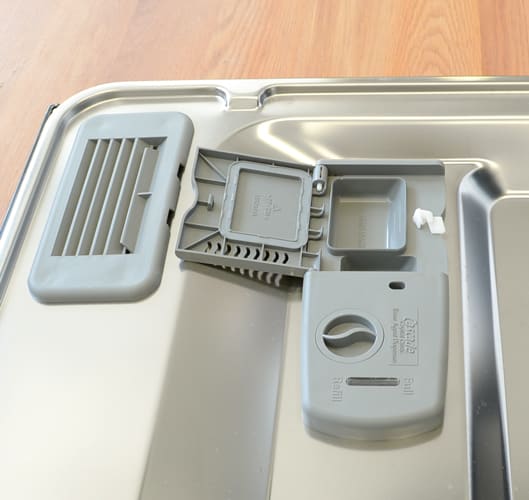
The CDWT980VSS detergent dispenser.
Ease of Use
{{section_header}}{{section.name}}{{/section_header}}
It wouldn’t be Ikea if it weren’t easy to use. Aside form the shallow cutlery basket and the lack of adjustability, no user will have much trouble figuring out how to operate this machine.
Noise
{{section_header}}{{section.name}}{{/section_header}}
The Nutid dishwasher was considerably louder than we expected. Noise isn’t much of a concern for some consumers, as the noise dishwashers make tend to be soft and unobtrusive, but don’t expect this thing to be a good companion for Elmer Fudd.
Controls
{{section_header}}{{section.name}}{{/section_header}}
The push-button interface is responsive enough, although the required pressure did seem a bit excessive. Overall, though, it is intuitive and easy to understand. That’s right kid, you can operate an Ikea dishwasher!


Efficiency
{{section_header}}{{section.name}}{{/section_header}}
The Nutid is not very efficient. By using the Normal wash 50 percent of the time (a cost of roughly 16 cents per wash), the Nutid will consume enough electricity and hot water to rack your utility bill by about $34.67 per year.
Washing Performance
{{section_header}}{{section.name}}{{/section_header}}
This is definitely the Nutid’s strong suit. While it doesn’t have a quick cycle, the Normal and Heavy washes were able to handle even the toughest stains. We were particularly amazed by the Heavy cycle’s perfection in our burnt cheese test (in which be bake a slice of cheese into a porcelain bowl). If all you’re looking for is performance, this machine is a solid option.
Features
{{section_header}}{{section.name}}{{/section_header}}
Not much by way of features, but it’s certainly not lacking. The basics are all included—rinse, sanitize, heated dry, delay. But it’s that lack of a quick wash that kept bugging us. Then again, it all depends what you’re looking for.
Meet the tester
Tyler Wells Lynch is a freelance writer and journalist whose work has appeared in Vice, Wirecutter, Gizmodo, The Rumpus, Yes!, and the Huffington Post, among others. He lives in Maine.
Checking our work.
Our team is here to help you buy the best stuff and love what you own. Our writers, editors, and experts obsess over the products we cover to make sure you're confident and satisfied. Have a different opinion about something we recommend? Email us and we'll compare notes.
Shoot us an email